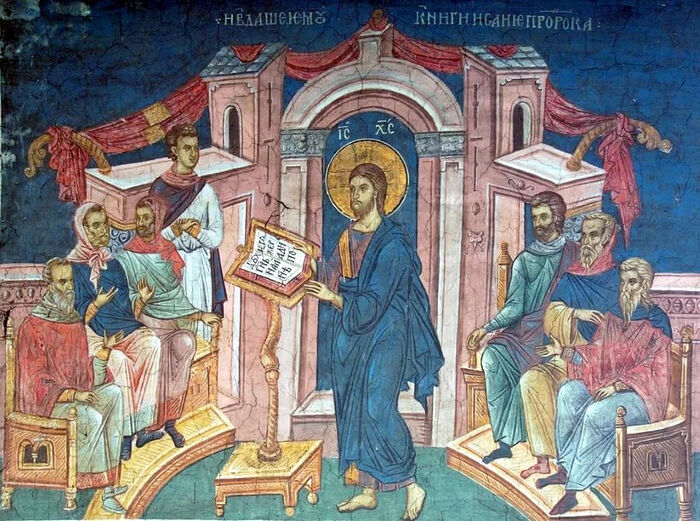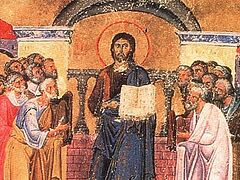On September 1/14, Orthodox Christians celebrate the Ecclesiastical New Year, also known as the Beginning of the Indiction. We offer our readers a theological-philological commentary on the troparion and kontakion of the feast.
The Church New Year, also known as the Indiction, is a fifteen-year period used as a unit of chronology. Not much is known about the origin of this system of chronology itself. The first mention of the term occurs after 297 AD in the documents of Roman Egypt, as a designation of the tax reporting period. It was first established as a five-year period, but starting in 328, the regular indiction became a span of fifteen years.
The official Byzantine reckoning, called the Indictions of Constantine the Great or the Constantinople Computation, began with September 1, 312. At the same time, there’s the idea that it was introduced later—under Emperor Leo I, or possibly even later.
The festive celebration of the New Year on September 1 is testified to in the Typicon of the Great Church. On this day, the Church recalls the episode in Luke 4 that talks about how Jesus Christ read the prophecy of Isaiah about the coming of the acceptable year of the Lord (Is. 61:1-2) in the synagogue in Nazareth. In this reading, the Byzantines saw the Lord’s instruction to celebrate the New Year. Tradition connects this event with September 1, and in the Menologion of Basil II it says: “From that time on, He gave us Christians this holy feast.” This same Gospel pericope about the preaching of Jesus Christ was read by the Patriarch in a special festive rite celebrated on September 1. This Gospel is appointed for the Divine Liturgy on September 1 in the Orthodox Church today as well.
This feast is associated with the Old Testament tradition of the feast mentioned in the book of Leviticus:
And the LORD spake unto Moses, saying, Speak unto the children of Israel, saying, In the seventh month, in the first day of the month, shall ye have a sabbath, a memorial of blowing of trumpets, an holy convocation. Ye shall do no servile work therein: but ye shall offer an offering made by fire unto the LORD (Lev. 23:23-25).
According to Judaism, the first month of the calendar year is Nisan. All religious festivals are counted from it. They calculate it starting from the seventh month (Tishrei), when Rosh Hashanah—the Jewish New Year—is celebrated.
It should be noted that this isn’t the only Old Testament episode connected with this feast. It was in this month that Noah’s Ark came to rest on Mt. Ararat (Gen. 8:4). It was in this month that Moses descended from Mt. Sinai with the tablets of the Covenant (Ex. 34:29). It was in this month that the construction of the Tabernacle of the Lord began (Ex. 35), where the High Priest entered into the Holy of Holies but once a year. There were many other, no less important episodes of sacred history.
In Rus’, the celebration of the Ecclesiastical New Year on September 1 dates to 1492, although there is earlier evidence of the celebration of the aforementioned special rite dating back to the thirteenth-fourteenth centuries.
The liturgical texts, in particular the troparion and kontakion of the Beginning of the Indiction, contain key images that allow us to immerse ourselves in the history of the feast and directly participate in it.
Here are the troparion and kontakion:
Troparion:
O Fashioner of all creation, Who in Thine authority hast appointed the times and seasons: bless Thou the crown of the year with Thy goodness, O Lord, preserving in peace Orthodox Christians and Thy city, and save us through the prayers of the Theotokos.
Kontakion:
O Christ our King Who livest in the highest, Creator and Maker of all things, visible and invisible, Who hast fashioned days and nights, seasons and years: bless Thou now the crown of the year; preserve and keep in peace Orthodox hierarchs, this city and Thy people, O greatly Merciful One.
And the original Greek text:
Troparion:
Ὁ πάσης δημιουργὸς τῆς κτίσεως, ὁ καιροὺς καὶ χρόνους ἐν τῇ ἰδίᾳ ἐξουσίᾳ θέμενος, εὐλόγησον τὸν στέφανον τοῦ ἐνιαυτοῦ τῆς χρηστότητός σου, Κύριε, φυλάττων ἐν εἰρήνῃ τοὺς βασιλεῖς καὶ τὴν πόλιν σου, πρεσβείαις τῆς θεοτόκου, καὶ σῶσον ἡμᾶς.
Kontakion:
Ὁ ἀρρήτῳ σύμπαντα, δημιουργήσας σοφίᾳ, καὶ καιροὺς ὁ θέμενος, αὐτοῦ ἐν τῇ ἐξουσίᾳ, δώρησαι, φιλοχρίστῳ τῷ λαῷ σου νίκας· ἔτους δέ, τάς τε καὶ τάς εἰσόδους ἐξόδους, εὐλογήσαις κατευθύνων, ἡμῶν πρὸς τὰ ἔργα σου θεῖόν θέλημα.
Creator of the universe
The troparion and kontakion devote special attention to some immutable truths of creation: The Lord is the Creator of all creation: “O Fashioner of all creation, Who in Thine authority hast appointed the times and seasons.”
Immutable Christian truth asserts that the world was created by God: For by Him were all things created, that are in Heaven, and that are in earth, visible and invisible (Col. 1:16).
The word “creation” in the troparion is a translation of the Greek word κτίσις, which means the result of creative activity—that which is created by God. The “Fashioner” (Gk. δημιουργὸς) is the Lord God.
Then it speaks about the act of creating time. By His power, the Lord laid down and established times and years—periods, timeframes.
“Bless the crown of this year with Thy goodness”
After that comes a prayerful petition with the words of King David from Psalm 64:12: Thou crownest the year with Thy goodness. St. Athanasius the Great interprets this passage thus: “The time of the coming age is called the year, and it is called the crown of goodness because in it the saints will be crowned with great grace.”[1] This is a petition to bless the crown (from the Greek Στέφανος—the completed cycle of the seasons) with the goodness and mercy of the Lord.
The troparion ends with a traditional prayer request for the preservation of men—the chosen people of God, true Christians—in peace and salvation, by the prayers of the Theotokos and Ever-Virgin Mary.
“Who livest in the highest, Maker of all things, visible and invisible”
The kontakion of the feast begins with the words: “O Christ our King Who livest in the highest.” The royal title of the Savior signifies the teaching about the royal dignity of Christ. In Revelation, Christ is called King of Kings and Lord of Lords (Rev. 19:16).
The Lord Jesus Christ is the Creator and Maker. These synonyms are used for greater affirmation.
Then the line about God’s creations continues. The fourth day of creation is recalled, when the heavenly luminaries were created: the sun, the moon, and the stars to rule the day and night (Gen. 1:14-19). The times and seasons mentioned in the troparion for the feast, as well as the petition for the blessing of the crown of the year are reflected in the kontakion, thereby calling the faithful to give special attention to the need for God’s blessing before the beginning of the New Year.
***
With their bright imagery, the troparion and kontakion for the celebration of the Beginning of the Indiction draw attention to the majesty of God. These liturgical texts remind the faithful that He is the Creator and Maker of the visible and invisible worlds. Focusing the gaze of the faithful upon the crown of the Lord’s year, the troparion and kontakion call Orthodox Christians to ever remember that we must thank God for everything and entreat His blessing on all our daily works, before every New Year, before every new cycle of years.
[1] St. Athanasius the Great, Commentary on the Psalms. Moscow, 2011.





